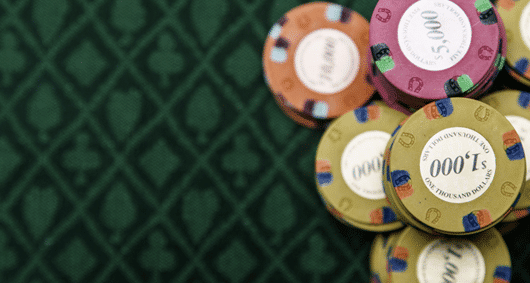For the remainder of this series I am going to break down tournaments into three stages. Exactly where these divisions occur is a little fuzzy, but roughly speaking the early, middle, and late stages of a tournament require different strategies, thus it’s convenient to treat them separately.
As a baseline I’m going to use a daily tournament that I play fairly regularly. The field is typically around one hundred players, paying twelve, with a first prize over $2.5k. Players start with 15K in chips with blinds at 25/50, and the tournament clock ticks off twenty minute levels. In going from level 3 to level 4, the blinds hold at 100/200 but a 25 ante kicks in. This is frequently a sign of a good, slow structure. The tournament does not include all the “Chainsaw-approved” intermediate levels, but frankly this is likely just as well since it still takes typically seven hours or so to reach a chop.

One additional feature of this tournament is that, as players bust out, the tables are broken down in a predictable order. That is, you know ahead of time if your table will break early or late. It’s true that sometimes this information becomes moot if you get moved to balance tables, but the vast majority of the time you will have a good idea of how long you’ll be playing with your original opponents. I explain below why you should care.
Deep-Stacked Tournament Play
The first factoid that may have popped out at you is that the tournament starts out deep at 300bb. This has a couple of important implications. First, it confirms this tournament has a slow enough structure to benefit the skilled player. Second, the recreational players who dabble in these things for fun spend most of their tournament lives at a stack depth somewhere around 50bb. As I suggested in the first article in this series, through either trial and error or conceivably actual study, many recreationals play this stack depth reasonably well. And most of them play exactly the same at 300bb as they do around 50bb.
Before elaborating on how we might exploit this, it’s worth pointing out that it’s the early levels of tournaments at which opinion diverges the most on the correct playing strategy. To unpack part of this, when single table sit-n-goes were essentially solved about a decade okay, it became universally accepted that early on tight was right. With a nine- or ten-handed field in which the top three got paid, the primary mission was making sure you cashed.
At the other end of the spectrum we have huge online tournaments with long-tailed pay-out structures. Here a min cash may amount to as little as 20% more than the buy-in. Meanwhile, the final table and top three places in particular offer the real money. In such structures you can make a compelling case that gathering chips through aggressive play is correct from the first hand.
Typical live tournaments, including the one I’m considering explicitly here, fall somewhat awkwardly in the middle. A min-cash in these tournaments may be around 2-3 times the buy-in, with first prize working out around ten times the min cash. In practice, however, these tournaments are frequently chopped multiple ways, so that in many cases you’re looking at a max-cash of about five times a min-cash. (I’ll cover chopping and deal-making in the final installment of this series, including whether or not it’s advantageous to you, the skilled player, to do so.)
The upshot of all of this is that I am aware of no firm consensus of how aggressively one should play the early stages of these mid-range tournaments. My personal preference is a “tight early” approach, although identifying particularly weak opponents may cause me to open up a bit against them in particular. Part of my reasoning is that I mostly play tournaments where I feel I have a substantial skill edge over the field, and the longer that skill edge has time to play out, the better I am likely to do.
Tight Play And Table Image
Another motivation for playing tight early is to set up a table image that I plan to exploit later. As the blinds increase and the antes kick in, there is simply more money as a function of stack depth sitting out there waiting to be grabbed. If the attentive players mark me as a nit, those increasingly large pots become easier to win.
Incidentally, this is the main reason why knowing the order in which tables will break is important. The longer you play with the same core of opponents, the more valuable the tight table image becomes. So the one situation in, say, a ten-table tournament in which I might play laggier than usual early on, is if I know my table will be one of the first couple to be broken down.
In addition to playing tight early, I also play more passively than I would in a cash game of the same stack depth. This is a strategy I picked up years ago watching a tournament video by Annette Obrestad. She was recording in real time, doing a dual-voice commentary with a relative tournament beginner. This individual, familiar with Annette’s reputation as an aggressive player, was stunned when she flatted a level 2 open raise with QQ. “Why not 3-bet?” he asked. Annette’s explanation was essentially that there was little to be gained and much to be lost by bloating the pot. And since she figured she was one of the best players in the tournament, she preferred to avoid situations that were more likely to lead to the hand playing for stacks.
Pushing Small Edges
This gets us to another question that pops up in forums and from students. “If I have a 51/49 spot early in a tournament, should I take it?” The purist answer is a resounding “yes.” Early on in a tournament, the differences between it and a cash game (or, more accurately between chip EV and cash EV) is negligible, thus any +EV spot that you would take in a cash game should also be taken in a tournament.
It seems to me this answer fails to take into account a couple of relevant considerations. First, and somewhat prosaically, there is always a difference between a live tournament and a cash game. You had to get to the casino. That took time and planning your schedule. If you take that 51/49 in a cash game and lose, you presumably have the next buy-in ready to put in play, thereby allowing you to play out your session for the full time you allocated to it. Unless you’re in a rebuy or the re-entry period of a tournament, that obviously is not the case. Busting out early has a utility cost in terms of time and travel.

There are always mitigating circumstances, of course. On one occasion I was in the early stages of a tournament and realized to my horror that a PLO game populated by people – let’s just say they were neither sober nor good at PLO – had broken out a couple of tables away. It occurred to me there might be merit in pushing 45/55 anti-edges in the tournament given how good the cash game looked.
Exploiting Typical Tournament Opponents
I mentioned above that in the first couple of levels, your recreational opponents will be playing at stack depths that are unusual for them. This has a couple of important consequences. To illustrate them, imagine the following hypothetical player. They have studied poker strategy at 30-50bb depth, but have no understanding of how deeper stacks should modify that strategy. What errors would such a player make? I think the most obvious, and the one I see most frequently in practice, is stacking off for a huge number of blinds with top pair.
In addition to these rather spectacular bust outs, you’ll also find these tournament players tend to be quite sticky postflop, particularly compared to low-limit cash players. This is considerably more difficult to counter, simply because in some frequency-based sense the tournament players are playing closer to theoretically correct.
So how do we handle these traits? First, despite playing tight, it should be apparent that getting into pots for a single raise with speculative hands is going to be highly profitable. This is, of course, fairly standard deep-stacked cash strategy, but it is far more rewarding in a tournament setting versus players who stack off with top pair for ~200bbs.
Second, bluffing in the early levels is hazardous. It’s counter to my goal of setting up a nitty table image, but also tends to get impaled on second pair, decent kicker that many of these players simply won’t fold. I’m convinced this is an area in which good cash game players go wrong and/or get tilted. It’s one thing to correctly identify that your opponent has a capped range, but if you try to blow them off it when they simply don’t fold, there’s no use in complaining about what a calling station they are. Just assume it’s 2005 and take value lines. There will be plenty of time for stealing and bluffing once the money is in sight.
Tournament Bet Sizes
Something that is true throughout a tournament is that raise and bet sizes are typically smaller than they would be in a live, low-stakes cash game. In $1/$2, for example, opens of 5x or more are standard. Even during the early stages of a tournament when stacks are deep, most recommendations are for an open around 3x. As I’ll discuss in future installments, this sizing drops with stack depth. 3-bets are similarly scaled down. If your cash 3-bet default is 3.5x the raise in position and 4.5x out of position, you can reduce those a bit even when deep. Significant downsizing becomes more important as the stack depth decreases.
Postflop bet sizes in tournaments also typically scale down a bit, but my feeling is this more reflects the shallower stacks at which many of the pots occur. If you’re a cash-game player who typically plays 100bb deep, your standard postflop bet sizing should work fine in the early stages of tournaments. If in doubt, shade down.
Despite these conventions, you’ll often see recreational players make enormous raises in the early levels. You’ll also see a great deal of limping and massively multiway pots. Playing low-stakes cash will have you prepared for these dynamics, but realize that if someone opens for 8x in a tournament, they probably don’t know what they’re doing. Or they have JJ; there are plenty of bet-sizing tells given off by these folks, so pay attention.
It used to be that the “early stages” ended neatly right before the antes kicked in, which in the perfect world for a poker author also coincided with the end of any re-entry period. In the specific tournament I’m considering here, antes come in at level 4 at which point the average stack is around 80bb, with two more levels before re-entry ends. The importance of the arrival of the antes is so great that I think it makes a useful dividing line between this and the next article.
To read the next installment in this series, please click here.

